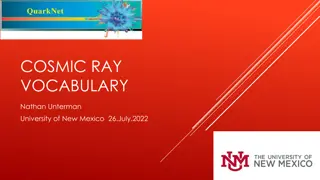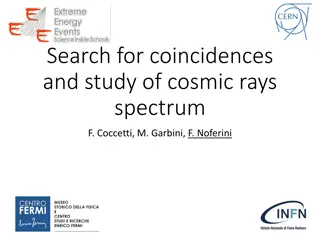Searching for Dark Photon Dark Matter with Cosmic Ray Antideuterons
Exploring the use of cosmic ray antideuterons for dark matter detection is a promising avenue in astrophysics. Antideuteron searches offer a low-background environment, making them ideal for detecting certain types of dark matter particles. Unlike antiproton searches, which face significant background challenges, antideuteron searches benefit from the production process that keeps background levels low. Instruments like the General AntiParticle Spectrometer (GAPS) are actively involved in this research field, utilizing exotic atom techniques to capture low-energy antiparticles and studying their interactions to uncover potential dark matter signatures.
Download Presentation

Please find below an Image/Link to download the presentation.
The content on the website is provided AS IS for your information and personal use only. It may not be sold, licensed, or shared on other websites without obtaining consent from the author. Download presentation by click this link. If you encounter any issues during the download, it is possible that the publisher has removed the file from their server.
E N D
Presentation Transcript
Searching for Dark Photon Dark Matter with Cosmic Ray Antideuterons Lisa Randall (w/Linda Xu) Mary K Fest Sept, 2019
Why Antideuteron Searches Indirect detection one of three pillars of WIMP searches Antiparticle and distinctive photon signatures have potential to find unusual cosmological processes What to look for? Positrons, photons, antiprotons However, few DM models favor first two More importantly, background difficult to calculate Discoveries have taught us some interesting unanticpated astronphysics Antiproton searches promising, but background big there too Antideuteron searches for same type of dark matter as antiprotons But background low at small kinetic energy (astro background higher KE) Makes it a potentially essentially background free measurement Only a few detections suffice for discovery
Why So Little Background? Assuming proton collides with X in ISM, To make an antiproton, at least four nucleons in final state To make an antideuteron, you need at least six Threshold energy First case 7 mp Antideuteron 17 mp Binding energy is 2.2 MeV Hard to slow down without dissociating Low background targets are good places to search DM annihilations usually close to at rest Possibility antiproton and antineutron produced with relatively small momentum difference In which case can coalesce Rare process But background calculable and essentially nonexistent (for low T)
Is anyone looking? Yes!! In principle AMS II General AntiParticle Spectrometer (GAPS) Antarctic balloon mission Looks for antideuteron <0.25 GeV/n Uses an exotic atom technique Slow low energy antiparticles so they get captured by a nucleus Exotic atom decays emitting X-ray Correlated pion, proton from subsequent nuclear annihilation
GAPS Long duration balloon experiment Antideuterons captured and result in exotic atom in final state Decays into X-rays at well-defined energies Plus a correlated pion signature Time of flight detection to tag events and particle velocities Distinguish from eg antiprotons Si/Li detctors for X-ray resolution and particle tracking Schedule 2011 prototype 2014 full experiment from Antarctica
That was then. This is now. Last slide from talk in 2010 Even then struggling to see which direct dark matter models permitted in light of direct detection But GAPs now planned for 2020/21 What can it do?
WIMP status? Dark Matter searches important but so far negative results WIMPs based on thermal relic density compelling But constrained if directly interacting with SM Viable option: Hidden Sector Dark Matter DM annihilates to other dark particles They in turn annihilate to SM Dark gauge fields most promising
Dark Matter/Dark Photon Dark photons mix with SM photon Permits Cascade annihilation if kinematically allowed Energy injected into radiation, leptons, baryons Provide constraints and detection prospectsas we will see We will argue antideuterons probe an as-yet unexplored mass range Tens of GeV
Constraints from Previous Measurements Indirect detection provides bulk of constraints Mass vs cross section Limits on CMB energy injection Limits from photon searches Limits from antipositrons Limits from antiprotons
Constraints on Mixing Indirect detection essentially independent of mixing Upper bounds mostly from Direct Detection Production essentially insensitive to Lower bounds to avoid BBN interference Also bound for observability Don t escape halo before froming antideuterons
Other light dark photon dark matter searches
Antideuteron We will show can probe tens of GeV range through antideuteron searches Challenge to theorist is correctly predicting Lots of uncertainties as we will discuss Still very promising
Theory Steps Need to compute injection Compute antideuteron formation Coalescence model Background: pp->pppbar, ppnbar Monte Carlo Annihilation to quarks, gauge bosons Subseqeuent hadronization and fragmentation Kn- kp<(2mpB)1/2~70MeV,~pcoal most likely form antideuteron Use data from Z decay pcoal~150MeV Diffusion and convection of cosmic ray density Transport in solar environment: modulation and structure of magnetic field
Also Need Halo Profile These results we use Einasto Less important than sensitivity to transport parameters
Propagation Through Galaxy and Heliosphere Need transport through ISM and Heliosphere (ToA; top of atmosphere) Again phenomenological parameter choices Use diffusion model
Conclusion Dark matter (by definition) elusive We should look in all ways possible Models play a big role suggest new searches Dark photon dark matter receives a lot of attention WIMP still possible But hard to find Antideuteron promising for interesting tens of GeV range Not necessarily all parameters but sizable reach Discovery possible! Hopefully launch successfully soon!






















